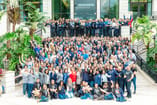When innovating, it’s inevitable that software engineering teams will face setbacks. The important question is: When something goes awry, how will they react?
At e-commerce company Grainger, Senior Director of Product Engineering Jenny Ore tells her team to resist pointing fingers and playing the “blame game.” Instead, she expects her engineers to work together to understand the issue, figure out how it happened and resolve the problem for the future.
“It’s a discussion and learning experience for everyone,” Ore said. “We’re all working toward the same goal.”
Scenarios like this exemplify a company culture of ownership in which no challenge is someone else’s problem. Rather, at workplaces like the five Chicago companies featured below, engineering teams are confident in their ability to come together to solve any problem.
In collaboration with each other and other departments, engineers at these companies are empowered to own all parts of development, from inception through product support. When overseeing projects, managers are intentional about providing engineers with trust, autonomy and support.
Instead of forcing certain answers or methods upon their teams, these engineering managers are careful to lead with questions and open up discussion opportunities. Ultimately, leaders find that this approach results in more invested teams and stronger solutions.
Built In Chicago connected with leaders from Morningstar, Grainger, Adyen, AdAction and Evive to discuss how they created and maintain a culture of ownership on their engineering teams and what challenges they have encountered along the way.

At Morningstar, a fintech company that connects people to investment information and tools, managers believe in leading by example, holding themselves accountable, trusting their teams and encouraging employees to share ideas.
What does a culture of ownership mean to your team?
For our team, a culture of ownership is having each person share in the pursuit of defining our mission and objectives. It is driven by the expectations we have of one another and our processes as a team.
It’s the ability for us to have autonomy, transparency and trust through constructive collaboration. It’s being accountable to each other in pursuing our best selves and work. We also seek what’s best for our team and clients.
You need to trust your team, include them in the decision-making process and look to them for their expertise and experience.”
What are the essential behaviors for a leader looking to exemplify and spread a culture of ownership across a team of engineers?
One essential behavior for leaders is to lead by example. As a leader, you should embody the mission and objectives of your team and company. Another is to be accountable. As a leader, you might make a decision that does not meet the expectations of your team or does not achieve what your team set out to complete. Own those decisions and their outcomes, considering what worked well and what did not, and share that with your team.
You need to trust your team, include them in the decision-making process and look to them for their expertise and experience. Finally, encourage and support individuals on your team to share and pursue their ideas with the team.
What was your biggest challenge in spreading a culture of ownership when you first became a manager, and how did you overcome it?
The biggest challenge I experienced as a manager was working with people who have a strong sense of ownership but have experienced and felt a lack of support from their leadership. Without that support, it can lead to individuals feeling there’s an additional obstacle to overcome.
In this instance, I worked with my team to create a space where we could have constructive conversations and build trust and empathy. Eventually, we brought together a community of individuals who share a sense of ownership for our team’s objective.
Grainger, an e-commerce platform mainly for industrial supplies, creates a culture of ownership by investing in engineers’ professional development and encouraging cross-departmental collaboration.
What does a culture of ownership mean to your team?
To create a culture of ownership on my team, I think about fostering two behaviors. The first is how our engineers build technology. Our engineers look at ownership from all angles — not just building, but from inception through production support. We work in tight collaboration with our partners in product management, user experience and operations to ensure we build holistically and learn along the way.
The other growth activity that lends itself to a culture of ownership is prioritizing learning and development, so an engineer can gain breadth and depth of knowledge. To encourage this type of learning, we have formal sessions like leadership roundtables, team Dojos, Communities of Practice and Ignite Week, during which we dedicate time each quarter to training.
We also encourage engineers to learn on the job by sharing roadmaps across teams and mob programming, when a small group of engineers work together in real time on one task. Our engineers create developments that bring unique value to Grainger, so any way we can foster curiosity and problem solving is time well spent.
Our engineers create developments that bring unique value to Grainger, so any way we can foster curiosity and problem solving is time well spent.”
What are the essential behaviors for a leader looking to exemplify and spread a culture of ownership across a team of engineers?
I always tell my team, “Don’t play the blame game if something goes wrong.” Instead, try to understand the issue, figure out how we got there and how to improve for the future. It’s a discussion and learning experience for everyone, and we’re all working toward the same goal.
Additionally, I empower our teams to make decisions. When teams make their own decisions, they are made faster and with more direct knowledge — but more importantly, teams learn from their decisions. One other thing I look for in my leaders is that they celebrate team wins, big and small. We don’t wait until big milestones to acknowledge and celebrate hard work and collaboration.
What was your biggest challenge in spreading a culture of ownership when you first became a leader, and how did you overcome it?
One of the biggest challenges when moving into a leadership role is the balancing act of taking the time to learn while strategically leading the team at the same time. One thing that helped me get through transitions was mentoring others. For me, mentorship is a two-way street, and I get just as much out of it. I found mentors with deep industry knowledge and technical expertise, who have worked at Grainger for many years.
This variety of perspectives helped me learn more about the business and therefore, learn how the work my team and I do makes our customers’ lives better. I really take pride in that.

For Adyen, a payment processing company for customers including Facebook and Uber, a culture of ownership means allowing engineering teams to make key decisions about products from start to finish. While the fintech startup grants its engineers trust and autonomy, leaders emphasize that it’s still important for managers to have their employees’ backs and step in when guidance is needed.
What does a culture of ownership mean to your team?
We make teams responsible for complete products. Every decision about what to build, how to build it and how to deploy it are made by the teams themselves. This creates an incredible speed and a lot of fun in the organization. Every engineer can bring up their ideas, discuss and validate them with others in the team, and make them happen. We call our company values the “Adyen Formula,” and one of the formula points is, “We include different people to sharpen our ideas.” I see this in action every day on our team.
Since we are a tech company that is pushing new innovations weekly, a culture of ownership is key to success. We don’t believe in ideas coming from the top-down; instead, teams consist of entrepreneurial engineers who continuously come up with creative ideas, launch new features and iterate over them.
Fostering a culture of ownership means finding balance between trust and understanding when to act.”
What are the essential behaviors for a leader looking to exemplify and spread a culture of ownership across a team of engineers?
There are a few drivers that are important for leaders at Adyen — we empower, we care and we act.
On the empowerment side, I’d like to mention an important aspect that may not be obvious: to focus on empowering strong performers. Often as leaders, we naturally spend time helping team members who are struggling. Strong performers also need guidance to become even more impactful. Nothing is more rewarding than seeing your top talents reach their full potential.
We care. I see a lot of leaders implementing a “culture of ownership” by telling their team members “do what you think is best.” Although important, this may lead to disconnect and engineers feeling lost. For me, the crucial part is to give freedom, but also have everyone’s backs. Actively supporting individuals and caring are crucial for success.
We act. I realize that culture is never a given. It continuously needs attention, and sometimes things may not go in the right direction. Fostering a culture of ownership means finding balance between trust and understanding when to act. It increases trust if everyone knows they’re empowered to make decisions, and that a leader will step in if needed.
What was your biggest challenge in spreading a culture of ownership when you first became a leader, and how did you overcome it?
I became a leader in my fourth year as an engineer. My biggest challenge was the one many leaders struggle with: balancing between doing the work yourself and delegating. Every time an exciting project was about to start, it was extremely tempting to jump on it, get my hands dirty and start coding. Coding is a lot of fun!
After a while, I realized this was not working great for the team and myself. I got swamped in work, was not always reachable to the team and became the bottleneck in critical projects. My challenge was not a lack of trust in my team members. My challenge was that I still liked making individual contributions too much.
How did I overcome it? This might surprise you: I stopped being a leader and moved back to an engineering role. At that time, I simply enjoyed the engineering work too much. A year later, I was ready. I figured out for myself how fun it was to lead a team and how rewarding it was to empower others to pick up the most impactful work.
At AdAction, a mobile app marketing platform, engineering teams adhere to a rule commonly posted at campground sites: “Leave it better than you found it.” This means encouraging innovation on highly collaborative teams who are accountable to each other and stakeholders.
What does a culture of ownership mean to your team?
For our team, it means having the trust and autonomy to make decisions in how we complete our work and how things are built. Everyone has a voice in not only the features we build and the enhancements that we make, but also the processes we follow. We put a lot of emphasis on continual improvement, always striving to get better each day as a team and as individuals.
It also means being accountable to each other and to our stakeholders. We expect people to reach out to each other when they feel stuck or unsure and may need some assistance. We also follow the campground rule of always leaving something better than you found it. This allowed us to create a highly collaborative environment where documentation and peer mentoring are the norm, even while working completely remotely and with flexible hours.
We feel people do their best work when they are engaged, empowered and have the freedom to be creative and innovate.
We feel people do their best work when they are engaged, empowered and have the freedom to be creative and innovate.”
What are the essential behaviors for a leader looking to exemplify and spread a culture of ownership across a team of engineers?
I think it starts with transparency and communication. People need to know what our goals are and where we are going, as a company and as a team. I think they also need honest feedback on what we are doing well and what needs improving.
It’s also important to be open and create a culture where everyone is comfortable with giving their viewpoint, speaking honestly and engaging in debate. I want people to explore new tools and ways of doing things and ultimately bring those ideas back to the team.
We also try to get our engineers involved very early on in the design and planning for a new feature or enhancement. This is to ensure they have a strong understanding of what is trying to be accomplished and so they have a voice in that process. It also creates a strong sense of ownership as the feature moves through our software development life cycle, allowing them to do their best work.
What was your biggest challenge in spreading a culture of ownership when you first became a manager, and how did you overcome it?
I think it can be really difficult to know where to start. When you are talking about shaping a team’s culture, that’s not something you can do overnight. You have to start small and build up, and focus on short-term goals that help you move in the right direction. We can’t improve everything all at once, but we can always improve something and raise the bar each day.
I also struggled with delegation and not needing to do everything myself. Fortunately, this one gets easier as others step in and take ownership of more, but it requires getting out of your comfort zone and trusting that those around you will step up.
At Evive, a healthtech company aiming to improve employee benefits utilization, leaders ask questions to open up discussion and debate among the team rather than thinking they hold all the answers. For supervisors looking to build a culture of ownership, Vice President of Engineering Ryan Booth encourages managers to surround themselves with fellow leaders on whom they can lean for advice and support.
What does a culture of ownership mean to your team?
At its foundation, it begins with empowering teams to own how they write code and architect systems, but it is much more than that. We strive to build engineering teams that have a deep understanding of our product and the problems our product solves, and to be part of the product solution.
Our engineering teams bring so much value beyond just the technical implementation details. For us, this means extending empowerment to ownership of a product outcome, determining the best ways to achieve that outcome and executing on that solution end to end.
I don’t have all the answers, and with a strong team, I don’t have to.”
What are the essential behaviors for a leader looking to exemplify and spread a culture of ownership across a team of engineers?
I could talk about a lot of things here, but I think the most important behavior is to ask a lot of questions. It may seem obvious, but it’s pretty hard to create a culture of ownership if you think you have all the answers and are simply telling your teams what to do all the time.
I don’t have all the answers, and with a strong team, I don’t have to. Asking questions is the best way I know of to open up debate and discussion. This leads to better engagement, allows the teams to take ownership of the problem and almost always leads to better results than any one individual would have come up with on their own. Asking questions like, “What would happen if we did x?” or “Do you have any concerns about z?” can also serve as a more subtle way to provide direction and allow teams to come up with the solution on their own.
What was your biggest challenge in spreading a culture of ownership when you first became a manager, and how did you overcome it?
I fell into some of the common traps new managers do. I had a tendency to micromanage, and I felt like it was my responsibility to figure everything out and to solve every problem myself. This was very exhausting, and I knew I couldn’t sustain it.
Fortunately, I had some great managers throughout my career who I could lean on for advice. Much like when you face issues while writing code, you probably aren’t the first one to encounter a problem as a manager. Smart people have likely already figured out a way to solve it, so I always start there. As a manager or an individual contributor, I think it’s always super important to have a manager you can learn from.
















